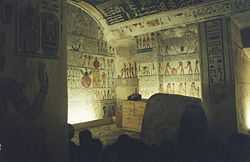KV9
| KV9 | |||
|---|---|---|---|
| Burial site of Ramesses V & Ramesses VI | |||
 | |||
 KV9 | |||
| Coordinates | 25°44′24.6″N 32°36′04.7″E / 25.740167°N 32.601306°ECoordinates: 25°44′24.6″N 32°36′04.7″E / 25.740167°N 32.601306°E | ||
| Location | East Valley of the Kings | ||
| Discovered | Open in antiquity | ||
| Excavated by |
James Burton Georges Daressy | ||
|
| |||
Tomb KV9 in Egypt's Valley of the Kings was originally constructed by Pharaoh Ramesses V. He was interred here, but his uncle Ramesses VI later reused the tomb as his own. The layout is typical of the 20th dynasty – the Ramesside period – and is much simpler than that of Ramesses III's tomb (KV11). The workmen accidentally broke into KV12 as they dug one of the corridors.
The tomb was featured in the first episode of the 2005 BBC documentary series How Art Made the World.

Isometric, plan and elevation images of KV9 taken from a 3d model
References
- Reeves, N & Wilkinson, R.H. The Complete Valley of the Kings, 1996, Thames and Hudson, London.
- Siliotti, A. Guide to the Valley of the Kings and to the Theban Necropolises and Temples, 1996, A.A. Gaddis, Cairo.
External links
| Wikimedia Commons has media related to KV9. |
- Theban Mapping Project: KV9 - Includes description, images and plans of the tomb.
- Views of KV9 & KV12
| ||||||||||||||||||||